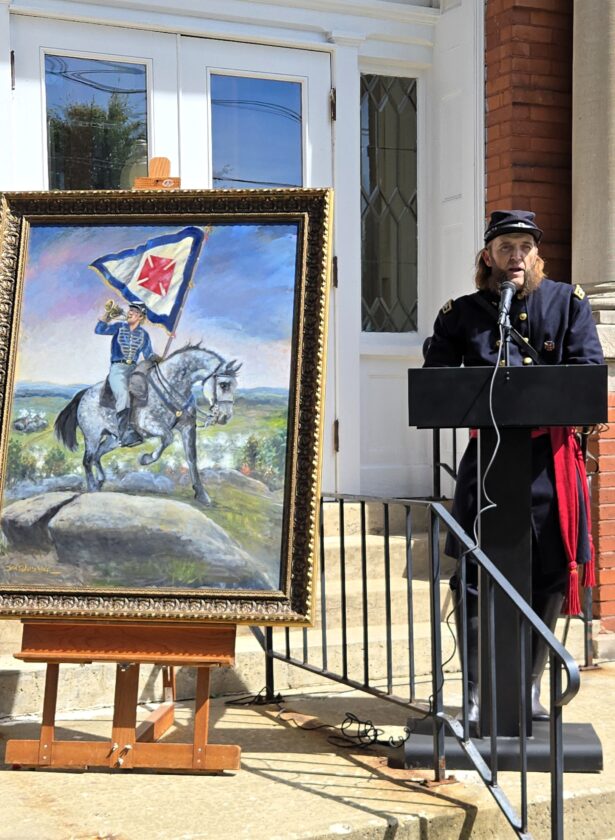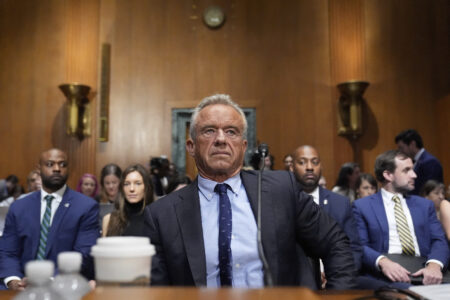Friend To Sherman
Ceremony Pays Tribute To Giving Of Civil War Hero

Tom Hansen, dressed as Col. Strong Vincent, speaks to those assembled in front of the Minera Library in Sherman about Civil War Veteran Oliver Willcox Norton’s friendship with Vincent.
SHERMAN — Few people realize the contributions to Sherman made by Civil War Veteran Oliver Willcox Norton, but those who attended a special ceremony on Aug. 18 at the Minerva Library know of his heroism.
The library, in which Oliver Willcox Norton had a particular interest, received a gift from the village of Sherman to remind people of Norton’s contributions. An original painting by Sherman native Susan Tewinkle Wolfe shows Norton at the Battle of Little Round Top in Gettysburg, Pa., where he served with Colonel Strong Vincent.
Norton was instrumental in the construction of the Minerva Library as well as contributing to the infrastructure of the village, to the school and projects throughout the town.
Present at the ceremony was Tom Hansen, the official Colonel Strong Vincent graveside speaker, who described Norton’s services and friendship with Vincent. Tribute speaker Jari Villaneuva, retired USAF band member and bugler, spoke on Norton’s contribution to “Taps,” to the Civil War, to industrial development and, of course, to Sherman.
In her introduction, Village of Sherman Mayor Colleen Meeder said that she saw a painting of Norton by Wolfe and got the idea to commission a painting for the library. “I fell in love with the painting and asked if the village could buy it and donate it to the Minerva Library,” she said. “Of course, if you know Susan, the painting she had was not good enough.”
Wolfe spent nearly a year and a half researching the life of Norton and working the details of his life into the painting. “I worked off and on, beginning in January of 2024,” she said. “I’ve done a lot of paintings that have taken a lot of detail, but this one took a lot of research and imagination.”
Wolfe said she took an artistic approach to the painting and tried to show the many honors Norton received in his life. For instance, the painting shows Norton, who was both a color guard and bugler, with both objects. Obviously, Wolfe said, he could not have been doing both at the same time.
Also, Wolfe said, the split rock in her painting is the one on which Strong Vincent was shot at the Battle of Little Round Top. She had seen it in many photos, but did not immediately realize its significance. “I’m pretty happy with how it turned out. I hope it will be around for a long time and I hope it piques the interest of both adults and kids,” Wolfe said. “It has been a great experience.”
Hansen, who wore the attire of Colonel Vincent, spoke about Norton’s experience with the colonel. Norton began bugling for Vincent in 1863, Hansen said, and in the spring, their brigade was ordered to head north to Gettysburg. Vincent learned that there was a gap in the Federal line on Little Round Top and he had Norton bugle the command to go forward, he said.
During the battle, Vincent saw that the 44th New York Regiment was faltering and pushed his men forward to keep the line from collapsing, Hansen said. Norton handed the colors off and grabbed a musket to join Vincent. Vincent stood on the split rock depicted in the painting and cried out “Don’t give an inch,” after which he was mortally wounded.
Norton visited Vincent at the farmhouse where he lay for five days before dying. Vincent asked about the battle and Norton reassured him that the soldiers had held the line for him, Hansen said.
Tribute speaker Jari Villanueva, an expert military bugler and ceremonial trumpeter, as well as an acclaimed “Taps” bugler, talked about Taps and Norton’s part in its history.
In July of 1862, Norton was serving with General Dan Butterfield at Harrison’s Landing in Virginia. Butterfield, who enjoyed writing bugle calls, did not like the call for “lights out,” Villanueva said, so he asked 23-year-old Norton to help him compose a new call.
The next evening, Norton played it and afterwards other buglers came and asked him about it. The call caught on quickly and, by the end of the war, even Confederate troops were using it, Villanueva said. It was officially recognized by the United States Army in 1874.
Norton’s involvement with the Minerva Library started when he was writing letters to his sister Libby, who lived in Chautauqua County and, later, in Sherman, Villanueva said. Libby had become involved with the Minerva Club which was seeking to establish a library in Sherman.
Norton and his family started visiting Chautauqua County and he became involved in the Minerva Club, as well, Villanueva said. Norton and his brother had become wealthy in the canning industry and he donated $1,000 to purchase the land and $10,000 for the building of the library, he added. “He wanted it to be the best built and best equipped library in Western New York,” he said.
The library opened May 19, 1908, but Norton was not finished with Sherman, Villanueva said. He contributed to the water system, to the school, and to the soldier’s monument, among other things, he added.
In all, Norton contributed more than $75,000 to Sherman, but he insisted on keeping his name out of public records, Villanueva said. “The Minerva Club continued to honor Oliver Willcox Norton every year, he said, but it was decades before the people of Sherman knew who was behind all of these improvements,” he said.
Norton also made many contributions to municipalities and to the arts in Chicago and New York, Villanueva said. “I look at him as a great example of what an American should be,” he said. “He kept giving back.”



